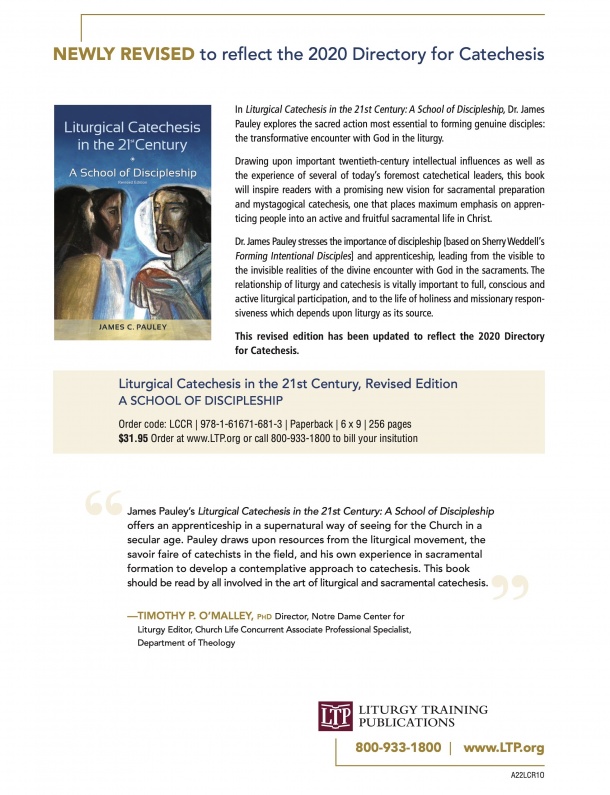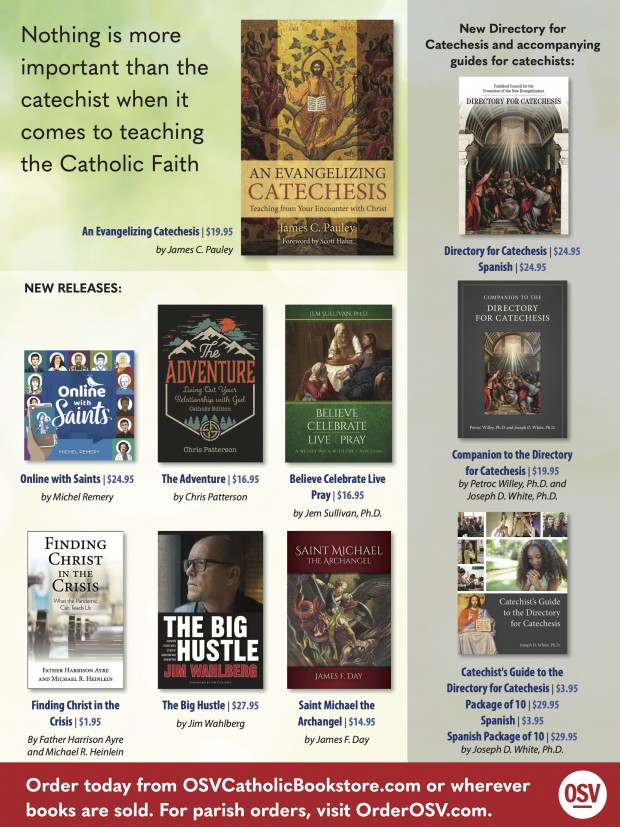AD: Order James Pauley's newly revised Liturgical Catechesis book!
To order James Pauley's Liturgical Catechesis in the 21st Century, Revised Edition, go to www.LTP.org or call 800-933-1800.

The Spiritual Life: “The Body of Christ” and “Amen” – What They Mean and What We Are Saying
Each year, the Church celebrates the Solemnity of the Most Holy Body and Blood of Christ. Corpus Christi: “the Body of Christ” in Latin. Of course, every Mass is a special celebration of the Body of Christ because every Mass is centered on the Eucharist. But for the Solemnity of Corpus Christi, the Church, in a particular way, invites us to be especially mindful of this mystery of faith, to embrace more fully the sublime magnificence of that which is the centerpiece of our religion, the very heart of Catholicism.
When we come forward to receive Holy Communion, we bow our heads in reverence to the gift that we are about to receive. Some people genuflect before receiving. Some people even fall to their knees in order to receive in the holy posture of kneeling. And if we receive Holy Communion on the tongue, then we open our mouths like helpless infants seeking to be fed; if we receive on the hand, then we hold our hands up like helpless beggars hoping for some charity, presenting the open hands like holy thrones upon which Jesus Christ, the King of kings and Lord of lords, will be seated when we receive him. “Lord, I am not worthy that you should enter under my roof, but only say the word and my soul shall be healed.” These words we say together, and they are the final words we speak before coming forward to receive the Lord. Because indeed, we are not worthy to receive Him. But he permits himself nonetheless to be received by us because it is only by his grace—and our words and actions done in faith in our response to his grace—that we are made worthy.
And this is pure gift, pure grace. We can do nothing to earn this, nothing to merit this, nothing to make ourselves worthy, only that we receive this precious gift in a state of grace and with proper disposition of heart and soul—humbly, worthily, and well.
Behold, the pierced One. Behold, the Lamb who was slain. Behold, the Suffering Servant, and the risen and glorified, majestic, and triumphant Lord. Behold, the Body of Christ.
AD: Sophia Institute for Teachers: Free, Faithful Resources
This is a paid advertisement in the October-December 2021 issue. Advertisements should not be viewed as endorsements from the publisher. To contact Sophia Institute click here. Or call 1-800-888-9344. Let them know you saw the ad here.

Practices and Prayers of Catholic Bereavement
 It’s strange to say it, but I love how we Catholics celebrate funerals. Even atheists walk away from our Masses of Christian Burial in awe. If only they (and likewise our own faithful people) could appreciate with greater fullness the rich spiritual heritage that surrounds Christian death!
It’s strange to say it, but I love how we Catholics celebrate funerals. Even atheists walk away from our Masses of Christian Burial in awe. If only they (and likewise our own faithful people) could appreciate with greater fullness the rich spiritual heritage that surrounds Christian death!
Editor’s Reflections: On Incarnational Coherence
Beneath the Basilica of the Annunciation in Nazareth is the place where tradition tells us the Angel appeared to the Blessed Virgin Mary. An altar stands in this grotto, inscribed with these words: “verbum caro hic factum est” (the Word became flesh here).
Jesus Christ: The Primary Liturgist
At the Last Supper, Jesus celebrated his farewell meal with his disciples, the celebration of his approaching death and resurrection. It was the culmination of the entire saving mission of the Lord, as well as the assurance of the power of that very same event being ever present in time and space.
The bread, the Lord tells us, represented his body given for us, the wine his blood poured out for us. In celebrating this sacred meal with his disciples, Christ was giving to them, and to all mankind, what he had already offered to his heavenly Father, namely, his own self as a redeeming victim. All of this was accomplished through sacred signs, which continually made present this saving sacrifice so that all humankind could forever unite and share in it. Consequently, after the Ascension, when the glorified, risen Christ took his rightful place at the right hand of the Father, he did not leave us orphans but continued to act and to dispense grace through the Eucharist and the other six sacraments he had instituted during his earthly ministry. These would be sources of living grace that would flow into the hearts of all those who through faith would participate in them.
All of this is accomplished through humanly perceptible signs and symbols that not only signify grace but effect it through the power of the Holy Spirit. Initially, this saving event of Christ’s Passion, Death, and Resurrection took place in time and in history, once and for all, while simultaneously and in reality, transcending all time through the action of the Holy Spirit, the great catalyst who is always active in the liturgical life of the Church. “Christ is always present in His Church, especially in her liturgical celebrations." (Second Vatican Council, Constitution on the Sacred Liturgy Sacrosanctum Concilium (December 4, 1963), no. 7) Having come to us from the Father, Jesus now leads us back to the Father.
The Eucharist: Source of Cultural Renewal

Western Culture needs renewal. This task of ennobling culture is vast indeed, and requires each of us to be a part of it. There are no sidelines or bystanders. It has been said that “Culture is the root of politics, and religion is the root of culture.”[i] To go a step further, religion rests upon the worship of God, and the Eucharist is at the center of true worship. Therefore, the task of ennobling culture requires ennobling religion and, correspondingly, ennobling worship, at the center of which we find the living God present in the Eucharist. Christian disciples must set Jesus Christ in the Eucharist at the center of their lives, as the Eucharist truly is the source and summit of that life,[ii] from whom flows rivers of living water (Jn 7:38), and apart from whom they cannot have life (Jn 6:53). The Eucharist celebrated and the Eucharist lived can transform our lives, the lives of others, and our culture itself.
Notes
[i] Fr. Richard Neuhaus, quoted in “Richard John Neuhaus Society,” First Things, https://www.firstthings.com/richard-john-neuhaus-society.
[ii] See Second Vatican Council, Lumen Gentium, no. 11.
AD: Study Guides, Online Saints and more from OSV!
Order today from OSVCatholicBookstore.com or wherever books are sold. For parish orders, visit OrderOSV.com.

This is a paid advertisement in the January-March 2021 issue. Advertisements should not be viewed as endorsements from the publisher.
Sacramentales prácticos en la iglesia doméstica
La iglesia doméstica ocupa un domicilio: un departamento, una mansión, una cabaña, una granja, un pent-house, cualquier tipo de vivienda a la que llamamos hogar. Todo el mundo, desde el psicólogo junguiano casi agnóstico, Jordan Peterson, al “influencer” que se ha vuelto viral, el almirante de la marina William McRaven, y hasta tu propia mamá aboga a favor de ordenar el espacio donde uno habita como el primer paso hacia una vida exitosamente ordenada, tanto al nivel práctico como a nivel simbólico. Para aquellas personas que tengan una visión sacramental de la realidad, también diríamos que es a nivel físico y espiritual.
Comprendemos correctamente a la Iglesia a cada nivel - desde Triunfante hasta doméstica - como una comunión sagrada de almas, encarnadas corporalmente en la Tierra y destinadas para la gloria de la resurrección. Hasta el tiempo en cuando cesarán aquellos sacramentos sobre los que depende nuestra identidad católica y la creación está hecha perfecta, ¿cómo deberían los componentes sacramentales de la iglesia doméstica moldear a nuestra vida cotidiana? Nuestro Señor ha instituido los sacramentos y la Iglesia ha introducido varios sacramentales; por lo tanto, la iglesia doméstica debería justamente ver a sus rutinas regulares a la luz de la gracia. Sacramentales formales, oficiales y sacramentales comunes comprendidos más ampliamente[1] nos pueden orientar más profundamente hacia la vida sacramental litúrgica y la aplicación mejorada de sus frutos dentro de nuestra familia.
Bautismo
Cuando bendigo el agua nueva y oro por las personas que la utilizarán, pienso a veces que debería refrescar la fuente más seguido. Los efectos de iniciación primaria del Bautismo seguirán con nosotros para siempre a partir de nuestro encuentro con esa dichosa agua, simbólica de nuestra inmersión en los mares abiertos de este mundo para un viaje hacia el siguiente, incluso a través de las aguas de la muerte.[2] Los católicos contemplamos nuestra naturaleza material y espiritual y nuestra misión al irnos de la casa por las mañanas o irnos a la cama por la noche, haciendo uso del sacramental de agua bendita en nuestra iglesia doméstica, así como lo hacemos en nuestra iglesia parroquial. (¡Una hermosa fuente para colgar en la pared es un finísimo regalo para ofrecer a personas que se mudan a una casa nueva!) Otros sacramentales relacionados con el Rito del Bautismo incluyen objetos como veladoras benditas y hasta nuestra ropa. El expresar nuestra dignidad humana divinamente designada por medio del buen vestir recatado desde temprana edad, gracias al ejemplo de nuestros padres de familia y hermanos mayores, puede no solamente ahorrarnos más adelante unas batallas entre papás y adolescentes, sino que también formar una verdadera espiritualidad de nuestro carácter y llamado bautismales prepaándonos para el culto, el trabajo, el descanso y la recreación del día, todo en la medida correcta según el plan de Dios. “Los que han sido bautizados en Cristo, de Cristo se han revestido. Aleluya, aleluya.” [3]
Practical Sacramentals in the Domestic Church
The domestic church inhabits a domicile: an apartment, a mansion, a cabin, a farmhouse, a penthouse, any kind of dwelling that we call home. Everyone from the quasi-agnostic Jungian psychologist Jordan B. Peterson to the viral video sensation Navy Admiral William McRaven to your own mother advocates tidying up your living space as the first step to a successfully ordered life, both practically and symbolically. For those with a sacramental vision of reality, we would also say both physically and spiritually.
We rightly understand the Church at every level from Triumphant to domestic as a sacred communion of souls, embodied corporeally on earth and destined for resurrected glory. Until those sacraments upon which our Catholic identity hinges cease and creation is made perfect, how should the sacramental components of the domestic church shape our daily lives? Our Lord has instituted the sacraments and the Church has introduced various sacramentals; thus, the domestic church should rightly see its regular routines in the light of grace. Formal, official sacramentals and commonplace sacramentals understood more broadly[1] can profoundly orient us toward the liturgical sacramental life and better apply its fruits within our families.
Baptism
As I bless new holy water and pray for the people who will use it, I sometimes think I should be refreshing the font more often. Baptism’s premiere initiative effects continue with us forever from our encounter with that blessed water, symbolic of our immersion into the open seas of this world for a journey to the next, eventually even over the waters of death.[2] Catholics contemplate our material-spiritual nature and mission as we leave home in the morning or go to bed at night using the sacramental of holy water in our domestic church, just as we do at our parish church. (Beautiful wall-mounted fonts make very fine house-warming gifts!) Other sacramentals related to the Rite of Baptism include objects like blessed candles and even our clothing. Expressing our divinely-appointed human dignity in dressing modestly and sharply from a young age, as exemplified by parents and older siblings, can not only save some teenage fights later on but also form a true spirituality of our baptismal character and calling as we prepare for the worship, work, rest, and recreation of the day, all in proper measure according to the Lord’s plan. “You have put on Christ, in him you have been baptized. Alleluia, alleluia.”[3]
Confirmation
Look around your room. Our homes should have sacred artwork of patron saints. A shrine or corner or shelf for each family member can hold holy cards, religious articles, and spiritual reading materials. A spiritual director once wisely counseled to have some ongoing hagiography as spiritual reading on the side. All this relates to the Sacrament of Confirmation: the summons to be a saint, the particular saint that only you can be. Commemorate feast days; consider that the Church may well observe one for you one day. Young people of Confirmation age, especially, in discovering their personal and spiritual identities as well as struggling against sin that is so ubiquitous in the adolescent years, need constant inspiration and intercession from their patrons and angels. They also need authentic antitypes to the fantasy figures of superheroes, sports idols, and social media personalities. They learn secular stats and stories quite readily—studying the lives of our holy forebears, including our family histories, can similarly motivate a notoriously hard-to-motivate group. Further, having sufficient autonomy over decorating and caring for their individual spaces engenders responsibility and maturity that then transfers to better personal custody for what surrounds their souls. Sports or exercise gear might profitably be associated with the armor of salvation (Eph 6:10-17) to fight the good fight of faith as soldiers of Christ,[4] saintly witnesses to him in the world as Confirmation deputes us. Every fire and furnace, every lamp and light switch should be connected with the Holy Spirit’s warmth and brightness, creating an atmosphere around us filled with God’s presence.


